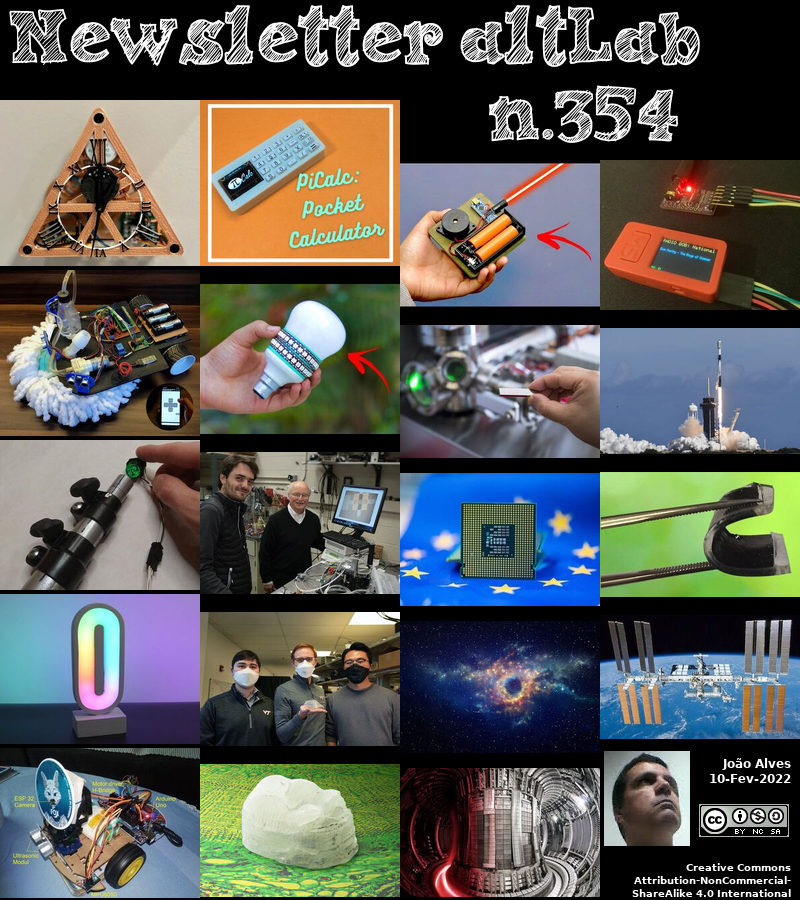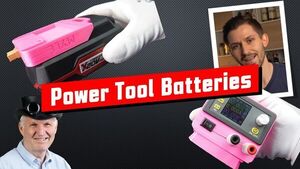2022-02-10 - Nº 354
Editorial
Esta é a Newsletter Nº 354 que se apresenta com o mesmo formato que as anteriores. Se gostar da Newsletter partilhe-a!
Todas as Newsletters encontram-se indexadas no link.
Esta Newsletter tem os seguintes tópicos:
Faz hoje anos que nascia, em 1846, o químico norte-americano Ira Remsen. Ele, juntamente com Constantin Fahlberg descobriram a sacarina. Ensinou química na Universidade Johns Hopkins de 1876 (onde se tornou o seu segundo presidente em 1901-13). Introduziu instrução laboratorial avançada usando métodos de ensino que tinha aprendido na Alemanha sob Rudolph Fittig. Especializou-se no anel de benzeno e grupos afins. Com Constantin Fahlberg, um estudante que trabalhava sob a sua direcção, sintetizou pela primeira vez o orthobenzoyl sulfimide (1879). Fahlberg descobriu acidentalmente o seu sabor intensamente doce ao tocar os seus dedos nos seus lábios enquanto, sem o saber, tinha alguns grãos sobre eles. O composto foi patenteado e comercializado sob o nome comercial de "sacarina".
Faz também hoje anos que nascia, em 1901, o Matemático germano-americano Richard Brauer. Ele foi pioneiro no desenvolvimento da teoria da álgebra. Trabalhou com Weyl em vários projectos, incluindo um famoso artigo conjunto sobre spinors (publicado em 1935 no American Journal of Mathematics). Este trabalho serviu de base à teoria de Paul Dirac sobre o electrão giratório no âmbito da mecânica quântica. Com Nesbitt, Brauer introduziu a teoria dos blocos (1937). Brauer utilizou-a para obter resultados sobre grupos finitos, particularmente grupos finitos simples, e a teoria dos blocos teria um grande papel em grande parte do trabalho posterior de Brauer. Começando pela caracterização teórica dos grupos simples (1951), Brauer passou o resto da sua vida a formular um método para classificar todos os grupos finitos simples.
Faz igualmente hoje anos que nascia, em 1902, o físico norte-americano Walter Houser Brattain. Ele partilhou (com John Bardeen e William B. Shockley) o Prémio Nobel da Física em 1956 pela investigação de semicondutores (materiais dos quais são feitos transístores) e pelo desenvolvimento do transístor. Na faculdade, disse ele, formou-se em física e matemática porque eram as únicas disciplinas em que ele era bom. Tornou-se um físico sólido com uma boa compreensão da teoria, mas a sua força estava na construção física de experiências. Trabalhando com as ideias de Shockley e Bardeen, as mãos de Brattain construíram o primeiro transístor. Em breve, o transístor substituiu o tubo de vácuo mais volumoso para muitas utilizações e foi o precursor de peças electrónicas micro-miniatura.
Faz também hoje anos que nascia, em 1931, o físico, engenheiro acústico e inventor norte-americano James West. Ele desenvolveu a tecnologia do transdutor de electrões e a aplicou para co-inventar o microfone de alumínio do electrão. Devido aos benefícios do seu baixo custo, alta sensibilidade e forma compacta, este tipo de microfone predomina agora na maioria das aplicações. A sua carreira tomou forma quando ainda era licenciado em Física. Após os Verões como estagiário no Departamento de Investigação Acústica da Bell Labs, West foi-lhe atribuído um cargo a tempo inteiro após a graduação em 1957. De 1960-62, trabalhou com Gerhard M. Sessler para aperfeiçoar o microfone electret e, em 1968, estava em produção em massa. O seu nome está em mais de 250 patentes. Este tipo de microfone é agora amplamente encontrado em telefones, câmaras de vídeo e aparelhos auditivos.
Por fim, faz hoje anos que nascia, em 1936, o cientista informático israelita Abraham Lempel. Ele é um dos pais da família LZ de algoritmos de compressão de dados sem perdas. Os seus trabalhos historicamente importantes começam com a apresentação do algoritmo LZ77 num artigo intitulado "A Universal Algorithm for Sequential Data Compression" no IEEE Transactions on Information Theory (Maio de 1977), co-autoria de Jacob Ziv. Os algoritmos LZ77 e LZ78 de autoria de Lempel e Jacob Ziv levaram a uma série de trabalhos derivados, incluindo o algoritmo Lempel-Ziv-Welch, utilizado no formato de imagem GIF, e o algoritmo de cadeia Lempel-Ziv-Markov, utilizado nos compressores 7-Zip e xz. Os algoritmos foram também utilizados como originalmente publicados em formatos como o DEFLATE, utilizado no formato de imagem PNG.
Em 1996 o campeão mundial de xadrez Garry Kasparov perde o jogo para o computador Deep Blue. Um computador IBM capaz de avaliar 200 milhões de movimentos por segundo. No entanto, o homem acabou por vencer a máquina, uma vez que Kasparov venceu o Deep Blue na partida com três vitórias e dois empates e levou para casa o prémio de 400.000 dólares. Cerca de 6 milhões de pessoas em todo o mundo acompanharam a acção online. Kasparov tinha anteriormente derrotado o Deep Thought, o protótipo do Deep Blue desenvolvido por investigadores da IBM em 1989, mas ele e outros mestres de xadrez tinham, por vezes, perdido para os computadores em jogos que duravam uma hora ou menos. O concurso de Fevereiro de 1996 foi significativo na medida em que representava a primeira vez que um humano e um computador o tinham eliminado num regulamento, jogo de seis jogos, em que cada jogador tinha duas horas para fazer 40 jogadas, duas horas para terminar as 20 jogadas seguintes e depois mais 60 minutos para encerrar o jogo.
E nesta semana que passou, uma ideia que tinha sido lançada no passado mês de Setembro deu mais um passo. Trata-se da soberania digital: A Comissão propõe a Lei dos Chips para fazer face à escassez de semicondutores e reforçar a liderança tecnológica da Europa. A Comissão propôs um conjunto abrangente de medidas para garantir a segurança do aprovisionamento, a resiliência e a liderança tecnológica da UE em tecnologias e aplicações de semicondutores. A Lei Europeia dos Chips reforçará a competitividade, a resiliência e ajudará a alcançar tanto a transição digital como a transição verde da Europa. A recente escassez global de semicondutores forçou o encerramento de fábricas numa vasta gama de sectores, desde automóveis a dispositivos de saúde. No sector automóvel, por exemplo, a produção em alguns Estados Membros diminuiu um terço em 2021. Isto tornou mais evidente a extrema dependência global da cadeia de valor dos semicondutores num número muito limitado de intervenientes num contexto geopolítico complexo. Mas também ilustrou a importância dos semicondutores para toda a indústria e sociedade europeia.
Na Newsletter desta semana apresentamos diversas noticias, artigos científicos, projetos de maker e alguns vídeos interessantes.
 João Alves ([email protected])
João Alves ([email protected])
O conteúdo da Newsletter encontra-se sob a licença  Creative Commons Attribution-NonCommercial-ShareAlike 4.0 International License.
Creative Commons Attribution-NonCommercial-ShareAlike 4.0 International License.
Novidades da Semana
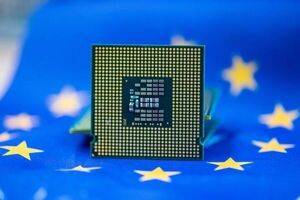
Digital sovereignty: Commission proposes Chips Act to confront semiconductor shortages and strengthen Europe's technological leadership
"Today, the Commission proposes a comprehensive set of measures to ensure the EU's security of supply, resilience and technological leadership in semiconductor technologies and applications. The European Chips Act will bolster Europe's competitiveness, resilience and help achieve both the digital and green transition. Recent global semiconductors shortages forced factory closures in a wide range of sectors from cars to healthcare devices. In the car sector, for example, production in some Member States decreased by one third in 2021. This made more evident the extreme global dependency of the semiconductor value chain on a very limited number of actors in a complex geopolitical context. But it also illustrated the importance of semiconductors for the entire European industry and society." [...]
Outras Notícias

NASA Telescope Spots Highest-Energy Light Ever Detected From Jupiter
"The planet’s auroras are known to produce low-energy X-ray light. A new study finally reveals higher-frequency X-rays and explains why they eluded another mission 30 years ago. Scientists have been studying Jupiter up close since the 1970s, but the gas giant is still full of mysteries. New observations by NASA’s NuSTAR space observatory have revealed the highest-energy light ever detected from Jupiter. The light, in the form of X-rays that NuSTAR can detect, is also the highest-energy light ever detected from a solar system planet other than Earth. A paper in the journal Nature Astronomy reports the finding and solves a decades-old mystery: Why the Ulysses mission saw no X-rays when it flew past Jupiter in 1992." [...]

Toshiba Launches Hall Sensorless Sine-wave Drive Three-phase Brushless DC Motor Control Pre-driver IC that Helps to Reduce Vibration and Noise
"Toshiba Electronic Devices & Storage Corporation ("Toshiba") has launched a three-phase brushless DC motor control pre-driver IC, “TC78B011FTG,” and started volume shipments today. The product is for high-speed motors, including those used in server fans and blowers, and in the suction motors of cordless and robot vacuum cleaners. TC78B011FTG adopts a sine-wave drive method that does not use Hall sensor control. This helps to reduce vibration and noise. In addition, a built-in closed loop speed control function allows a detailed speed profile to be programmed into the IC’s non-volatile memory (NVM), securing suppression of fluctuations in rotation speeds due to power supply voltage or load fluctuations without any need for an external MCU. Toshiba also mass produces TC78B009FTG, which adopts a rectangular-wave drive method that does not use Hall sensor control, and users can select the appropriate product for their motor drive method." [...]
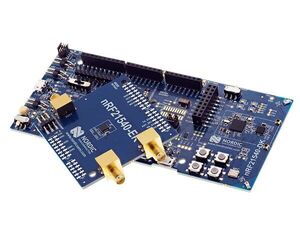
Nordic launches nRF21540 Development Bundle for product development with 2.4 GHz wireless range extension
"Development Bundle comprises a development kit and evaluation kit for familiarization, configuration, and testing of the range, link budget, latency, and power consumption improvements provided by the nRF21540 RF Front-End Module Nordic Semiconductor today announces the launch of the nRF21540™ Development Bundle (DB) - design tools for verification and testing of applications that require the range extension or link budget improvements provided by the nRF21540 RF Front-End Module (FEM). The nRF21540 DB comprises the nRF21540 Development Kit (DK) and the nRF21540 Evaluation Kit (EK). The previously released nRF21540 RF FEM is a power amplifier/low noise amplifier (PA/LNA) product. The RF FEM perfectly complements Nordic’s nRF52 and nRF53 Series multiprotocol Systems-on-Chip (SoCs). The product is targeted at applications that benefit from increased range when employing 2.4 GHz technology. Examples include industrial automation, lighting mesh networks and other home automation, asset tracking and wireless audio." [...]

Dual High-Side Switches from STMicroelectronics Add Extra Flexibility for Driving Capacitive Loads
"STMicroelectronics’ latest high-side switches, the IPS2050H and the IPS2050H-32, permit two programmable current-limit values for smart driving of capacitive loads that draw high startup current. These new dual-channel switches have an input-voltage range from 8V to 60V and can withstand up to 65V on the input pin, ensuring flexibility and robust performance in industrial applications. The integrated power MOSFET has low Rds(on), resulting in high energy efficiency and low thermal dissipation. In addition, MOSFET single-pulse avalanche energy greater than 1J at 2A boosts reliability for handling inductive loads. There is also an active clamp for fast demagnetization. The IPS2050H allows the main current limit to be programmed up to 2.5A for driving loads controlled by a PLC module and for use in equipment such as factory automation I/O peripherals, Computer Numerical Control (CNC) machines, and general driving of resistive, inductive, and capacitive loads." [...]

Toshiba Releases New MOSFET Gate Driver IC that Will Help to Reduce Device Footprints
"Toshiba Electronic Devices & Storage Corporation ("Toshiba") has released “TCK421G” for 20V power lines as the first product in its new “TCK42xG Series” of MOSFET gate driver ICs. Devices in the series are dedicated to gate voltage control of an external N-channel MOSFET, based on input voltage, and have an overvoltage lockout function. Volume shipments start today. TCK421G is suitable for configuring power multiplexer circuits or load switch circuits equipped with reverse-current blocking, in combination with a back-to-back connection of external N-channel MOSFETs. It incorporates a charge pump circuit that supports a wide range of input voltages, from 2.7V to 28V, and supplies stable voltage to the gate-source voltage of external MOSFETs with its intermittent operation. This allows switching of large currents." [...]

Astra launch of NASA-sponsored cubesats fails
"The first operational launch of Astra’s Rocket 3.3 vehicle failed Feb. 10 when the rocket’s upper stage appeared to tumble out of control after stage separation. The rocket, designated LV0008 by Astra, lifted off from Space Launch Complex 46 at Cape Canaveral Space Force Station at 3 p.m. Eastern. The launch suffered several days of delays because of a range issue as well as a last-second scrub during the previous launch attempt Feb. 7. However, onboard video of the vehicle showed the upper stage tumbling shortly after separation from the first stage, three minutes after liftoff. The video suggests a potential issue with the separation of the payload fairing, which, according to a mission timeline provided by the company, takes place seconds before stage separation. “An issue has been experienced during flight that prevented the delivery of our customer payloads to orbit today." [...]
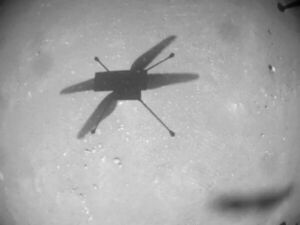
Mars helicopter Ingenuity aces 19th flight after historic Red Planet weather delay
"A dust storm pushed the liftoff date back by more than a month. The dust storm couldn't keep NASA's Mars helicopter Ingenuity grounded forever. The 4-pound (1.8 kilograms) Ingenuity aced a 100-second sortie on Tuesday (Feb. 8), its 19th Red Planet flight overall but its first since Dec. 15. The flight had originally been targeted for Jan. 5. But on New Year's Day, a big dust storm kicked up near the 28-mile-wide (45 kilometers) Jezero Crater, which Ingenuity and its robotic partner, NASA's Perseverance rover, have been exploring since February 2021. The Ingenuity team decided to stand down until the dust storm passed, making Ingenuity the first aircraft ever to have a flight delayed by inclement weather on another planet." [...]

Geomagnetic Storm And Recently Deployed Starlink Satellites
"On Thursday, February 3 at 1:13 p.m. EST, Falcon 9 launched 49 Starlink satellites to low Earth orbit from Launch Complex 39A (LC-39A) at Kennedy Space Center in Florida. Falcon 9’s second stage deployed the satellites into their intended orbit, with a perigee of approximately 210 kilometers above Earth, and each satellite achieved controlled flight. SpaceX deploys its satellites into these lower orbits so that in the very rare case any satellite does not pass initial system checkouts it will quickly be deorbited by atmospheric drag. While the low deployment altitude requires more capable satellites at a considerable cost to us, it’s the right thing to do to maintain a sustainable space environment. Unfortunately, the satellites deployed on Thursday were significantly impacted by a geomagnetic storm on Friday. These storms cause the atmosphere to warm and atmospheric density at our low deployment altitudes to increase." [...]
Ciência e Tecnologia
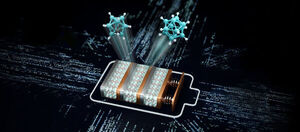
A new electrolyte for greener and safer batteries
"A UNIGE team has developed a new material that improves the performance of solid-state sodium batteries, a less dangerous and more durable alternative to lithium. The future of battery technologies lies in sodium. More sustainable than lithium - which currently powers most of our devices and vehicles - sodium is also abundant on the earth’s surface. The only problem is that its ions do not move easily in the liquid electrolyte of conventional batteries, making it less efficient than lithium. Therefore, the solution lies in the development of a solid electrolyte. A scientific team from the University of Geneva (UNIGE) has succeeded in meeting this challenge by modifying the crystal structure of a material composed of carbon, boron and hydrogen (carbo hydridoborate)." [...]
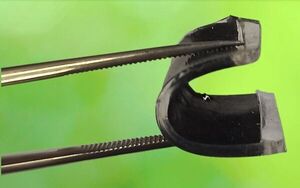
Surrey’s new flexible and stretchy supercapacitors could boost “battery” life for Internet of Things
"Smartwatches, fitness trackers and other Internet of Things devices could get a significant boost to their “battery” life thanks to new, environmentally friendly energy research from the University of Surrey’s Advanced Technology Institute (ATI) and the Federal University of Pelotas (UFPel), Brazil. In a paper published by the journal Nanoscale, the research team show how a supercapacitor can be efficiently manufactured into a high-performance and low-cost power storage device that can be easily integrated into footwear, clothing, and accessories. Professor Ravi Silva, Director of the ATI and Head of the Nano-Electronics Centre at the University of Surrey, said: “Supercapacitors are key to ensuring that 5G and 6G technologies reach their full potential. While supercapacitors can certainly boost the lifespan of wearable consumer technologies, they have the potential to be revolutionary when you think about their role in autonomous vehicles and AI-assisted smart sensors that could help us all conserve energy. This is why it’s important that we create a low cost and environmentally friendly way to produce this incredibly promising energy storage technology. The future is certainly bright for supercapacitors.” A supercapacitor is a means to store and release electricity, like a typical battery, but it does so with far quicker recharging and discharging times." [...]
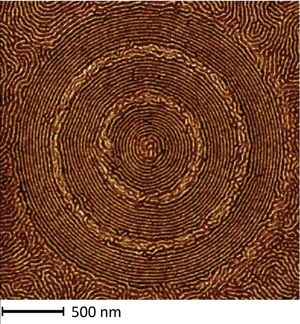
With a Little Help, New Optical Material Assembles Itself
"Breakthrough could enable large-scale manufacturing of nanomaterials for industry A research team led by Lawrence Berkeley National Laboratory (Berkeley Lab) has demonstrated tiny concentric nanocircles that self-assemble into an optical material with precision and efficiency. Their work overcomes a longstanding problem in nanoscience – molecular impurities. The researchers described their work in the journals ACS Nano and Advanced Materials. The new findings could enable the large-scale manufacturing of multifunctional nanocomposites – materials made from different components on a scale of a billionth of a meter. Such materials could enable advanced fiberoptics for high-speed broadband telecommunications, and multifunctional coatings for buildings, automobiles, and aerospace. As reported in ACS Nano, the new technique coaxes diverse blends of polymers and nanoparticles into spontaneously forming tiny nested rings within minutes of adding an impurity, such as a small organic molecule, to the mix." [...]
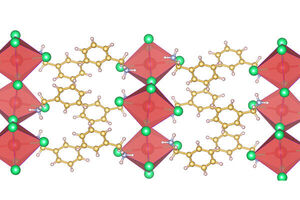
Perovskite research advances offer new possibilities for devices such as solar cells
"Perovskite materials are low-cost, solution-processable semiconductors that can absorb and convert solar energy with extraordinarily high efficiencies, making them promising material for use in applications such as photovoltaic solar cells – if the material can be made stable and efficient. In research published in the journal Chem, Los Alamos National Laboratory researchers have examined the performance properties of two-dimensional perovskites in conditions representative of a device structure, finding those structures can be as efficient as their three-dimensional counterparts. “We discovered that intrinsic to this material, there are some shallow defects or ‘trap states’ that can help the charge transport over a long distance,” said Wanyi Nie, researcher with the Center for Integrated Nanotechnologies group at Los Alamos National Laboratory. “The travel distance is slightly lower than three-dimensional perovskites, but is much greater than what people believed in a typical 2D quantum-confined system. So this is a critical finding that two-dimensional perovskites can be efficient as three-dimensional perovskites.” Investigating properties in a device structure for the first time Three-dimensional perovskites are unstable under ambient environmental conditions. Layered structures can circumvent that environmental instability." [...]

Scientists discover a mysterious transition in an electronic crystal
"Thermal span in a layered compound promises applications in next-generation electrical switches and nonvolatile memory. When temperature changes, many materials undergo a phase transition, such as liquid water to ice, or a metal to a superconductor. Sometimes, a so-called hysteresis loop accompanies such a phase change, so that the transition temperatures are different depending on whether the material is cooled down or warmed up. In a new paper in Physical Review Letters, a global research team led by MIT physics professor Nuh Gedik discovered an unusual hysteretic transition in a layered compound called EuTe4, where the hysteresis covers a giant temperature range of over 400 kelvins. This large thermal span not only breaks the record among crystalline solids, but also promises to introduce a new type of transition in materials that possess a layered structure. These findings would create a new platform for fundamental research on hysteretic behavior in solids over extreme temperature ranges." [...]
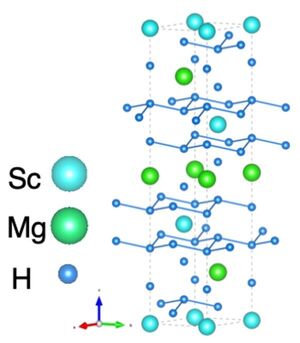
Predicting Superconductor Crystal Structures with Computer Simulations
"Researchers discover a new hydrogen compound crystal structure as a likely candidate for achieving superconductivity at high temperatures The low temperatures required to maintain superconductivity have led to the development of hydrogen-containing compounds (metal hydrides) that can achieve superconductivity at room temperature. Researchers from Japan Advanced Institute of Science and Technology have been using computer simulations to predict various metals that can be combined with hydrogen to form potential superconductors that require inexpensive cooling solutions. Their simulations can provide information on crystal structures and assist in the development of high temperature superconductors. Superconductivity refers to the loss of electrical resistance of a material and requires extremely low temperatures (< -200°C) in order to persist. This low temperature, otherwise known as the transition temperature, has been a limiting factor in the application of superconductors and finding materials that can display superconductivity at higher temperatures has become an important research objective worldwide. A breakthrough has been made with hydrogen-rich compounds (called hydrides) containing rare earth or alkaline metals, which display room temperature superconductivity at high pressures (100-200 GPa)." [...]
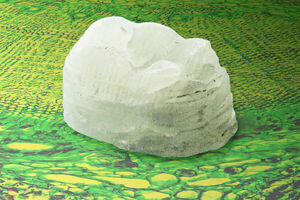
New plant-derived composite is tough as bone and hard as aluminum
"The material could pave the way for sustainable plastics. The strongest part of a tree lies not in its trunk or its sprawling roots, but in the walls of its microscopic cells. A single wood cell wall is constructed from fibers of cellulose — nature’s most abundant polymer, and the main structural component of all plants and algae. Within each fiber are reinforcing cellulose nanocrystals, or CNCs, which are chains of organic polymers arranged in nearly perfect crystal patterns. At the nanoscale, CNCs are stronger and stiffer than Kevlar. If the crystals could be worked into materials in significant fractions, CNCs could be a route to stronger, more sustainable, naturally derived plastics." [...]
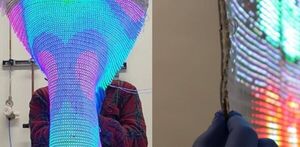
Scientists develop fully woven, smart display
"Researchers have developed a 46-inch woven display with smart sensors, energy harvesting and storage integrated directly into the fabric. An international team of scientists have produced a fully woven smart textile display that integrates active electronic, sensing, energy and photonic functions. The functions are embedded directly into the fibres and yarns, which are manufactured using textile-based industrial processes. The researchers, led by the University of Cambridge, say their approach could lead to applications that sound like sci-fi: curtains that are also TVs, energy-harvesting carpets, and interactive, self-powered clothing and fabrics. This is the first time that a scalable large-area complex system has been integrated into textiles using an entirely fibre-based manufacturing approach. Their results are reported in the journal Nature Communications." [...]

Rare earth elements await in waste
"Rare earth elements are hard to get and hard to recycle, but a flash of intuition led Rice University scientists toward a possible solution. The Rice lab of chemist James Tour reports it has successfully extracted valuable rare earth elements (REE) from waste at yields high enough to resolve issues for manufacturers while boosting their profits. The lab’s flash Joule heating process, introduced several years ago to produce graphene from any solid carbon source, has now been applied to three sources of rare earth elements -- coal fly ash, bauxite residue and electronic waste -- to recover rare earth metals, which have magnetic and electronic properties critical to modern electronics and green technologies. The researchers say their process is kinder to the environment by using far less energy and turning the stream of acid often used to recover the elements into a trickle. The study appears in Science Advances. Rare earth elements aren’t actually rare." [...]
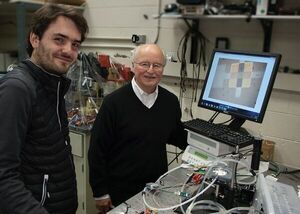
Light could boost performance of fuel cells, lithium batteries, and other devices
"With many devices depending on the motion of ions, light could be used as a switch to turn ion motion on and off. Engineers from MIT and Kyushu University in Japan have demonstrated for the first time how light can be used to significantly improve the performance of fuel cells, lithium batteries, and other devices that are based on the movement of charged atoms, or ions. Charge can be carried through a material in different ways. We are most familiar with the charge that is carried by the electrons that help make up an atom. Light has long been used to excite electrons to make them more conductive. Common applications include solar cells, and even supermarket doors that automatically open when a customer passes through." [...]
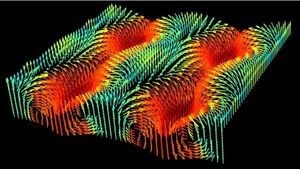
Tiny electrical vortexes bridge gap between ferroelectric and ferromagnetic materials
"Ferromagnetic materials have a self-generating magnetic field, ferroelectric materials generate their own electrical field. Although electric and magnetic fields are related, physics tells us that they are very different classes of material. Now the discovery by University of Warwick-led scientists of a complex electrical ‘vortex’-like pattern that mirrors its magnetic counterpart suggests that they could actually be two sides of the same coin. Detailed in a new study for the journal Nature, funded by the Engineering and Physical Sciences Research Council (EPSRC), part of UK Research and Innovation, and the Royal Society, the results give the first evidence of a process in ferroelectric materials comparable to the Dzyaloshinskii–Moriya interaction in ferromagnets. This particular interaction plays a pivotal role in stabilising topological magnetic structures, such as skyrmions, and it might be crucial for potential new electronic technologies exploiting their electrical analogues. Bulk ferroelectric crystals have been used for many years in a range of technologies including sonar, audio transducers and actuators." [...]
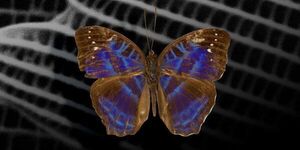
Applying the butterfly principle
"ETH Zurich researchers have created artificial colours by 3D printing certain nanostructures inspired by those of a butterfly. This principle can be used in the future to produce colour screens. For their new technology, scientists in the group of Andrew deMello, Professor of Biochemical Engineering, drew inspiration from butterflies. The wings of the species Cynandra opis, native to tropical Africa, are decorated with brilliant colours. These are produced by extremely intricate regular surface structures in the size range of the wavelength of visible light. By deflecting light rays, these structures either amplify or cancel out individual colour components of the light." [...]
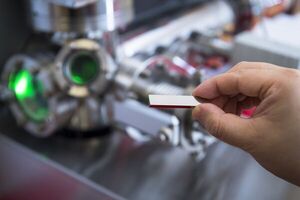
Super-elastic High-Entropy Elinvar Alloy Discovered with Potential for Aerospace Engineering
"Metals usually soften when they expand under heating, but a research team led by a City University of Hong Kong (CityU) scholar and other researchers have discovered a first-of-its-kind super-elastic alloy that can retain its stiffness even after being heated to 1,000K (about 727℃) or above, with nearly zero energy dissipation. The team believes that the alloy can be applied in manufacturing high-precision devices for space missions. The research team was led by Professor Yang Yong from CityU’s Department of Mechanical Engineering (MNE), together with his collaborators. The findings were published in the prestigious science journal Nature under the titled “A Highly Distorted Ultraelastic Chemically Complex Elinvar Alloy”. Usually the elastic modulus i.e. stiffness, of most solids including metals, decreases when the temperature increases as a result of thermal expansion." [...]
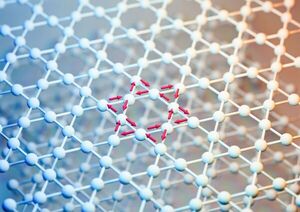
New insight into unconventional superconductivity
"Signatures for a novel electronic phase that enables charge to flow spontaneously in loops have been observed in a kagome superconductor. Using ultra-sensitive muon spin spectroscopy, researchers discovered time-reversal symmetry-breaking magnetic fields inside the material, indicating the existence of long-searched-for ‘orbital currents’. The discovery, published today in Nature, aids understanding of high-temperature superconductivity and quantum phenomena underpinning next-generation device research. The kagome pattern, a network of corner-sharing triangles, is well known amongst traditional Japanese basket weavers – and condensed matter physicists. The unusual geometry of metal atoms in the kagome lattice and resulting electron behaviour makes it a playground for probing weird and wonderful quantum phenomena that form the basis of next-generation device research. A key example is unconventional - such as high-temperature - superconductivity, which does not follow the conventional laws of superconductivity." [...]

Tiny, reusable sensing chip could lead to new point-of-care medical tests
"The key to its success? ‘Nanopatch antennas’ made with liquid metal that trap light to identify biological and chemical molecules The proliferation of point-of-care testing, from at-home blood glucose meters to COVID-19 rapid tests, is accelerating and improving medical care. Continuing to upgrade the sensing technology that is fueling the growth of these products, however, is becoming increasingly challenging. Some optical sensing chips, for example, contain nanostructures that are nearly as small as the biological and chemical molecules they’re searching for. These nanostructures improve the sensor’s ability to detect molecules. But their diminutive dimensions make it difficult to guide the molecules to the correct area of the sensor." [...]

Stanford engineers create a catalyst that can turn carbon dioxide into gasoline 1,000 times more efficiently
"Captured CO2 can be turned into carbon-neutral fuels, but technological advances are needed. In new research, a new catalyst increased the production of long-chain hydrocarbons in chemical reactions by some 1,000 times over existing methods. Engineers working to reverse the proliferation of greenhouse gases know that in addition to reducing carbon dioxide emissions we will also need to remove carbon dioxide from power plant fumes or from the skies. But, what do we do with all that captured carbon? Matteo Cargnello, a chemical engineer at Stanford University, is working to turn it into other useful chemicals, such as propane, butane or other hydrocarbon fuels that are made up of long chains of carbon and hydrogen. “We can create gasoline, basically,” said Cargnello, who is an assistant professor of chemical engineering." [...]
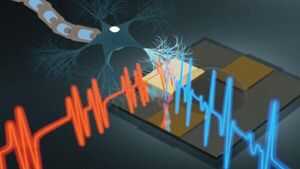
Focus on organic transistors for health sensors within living organisms
"QUT researchers are part of an international group who have explored ways in which organic transistors are being developed for use as wearable health sensors. The currently available bioelectronic devices, such as pacemakers, that can be embedded within the human body are mostly based on rigid components. However, the next-generation devices – which are researched and developed by bioelectronic engineers, organic chemists, and materials scientists – will use soft organic materials that allow comfortable wearability as well as efficient monitoring of health. In a study published and featured on the cover of the journal, Advanced Materials, Dr Ali Nawaz, from the Bruno Kessler Foundation, Trento, Italy, and QUT Centre for Materials Science researchers Professor Prashant Sonar, Professor Kathryn Fairfull-Smith, and Dr Qian Liu have reviewed the potential of organic electrochemical transistors for use in in vivo bioelectronic devices, which are devices suitable to be used within a living organism. The research was supported by the QUT Centre for Biomedical Technologies. First author Dr Ali Nawaz examined the characteristics of organic electrochemical transistors that make them particularly suitable to be operated within a living organism." [...]

Cornell software enables 3D printing on space station
"If deep space exploration is to become a reality, humans will need to be as self-sufficient as possible. Since ordering supplies from Earth won’t be practical, the astronauts will have to fabricate their own components for equipment and other products through additive manufacturing, better known as 3D printing. But the challenges for “Earth-independent manufacturing” are as vast as space itself. The lack of gravity, differences in time and spatial scales, and radical changes in temperature could all stymie the process, resulting in wasted material and unusable parts. Those challenges may be overcome thanks to modeling software created in the lab of Derek Warner, professor of civil and environmental engineering in the College of Engineering, and successfully tested aboard the international space station as part of a collaboration between Cornell, Hewlett Packard Enterprise (HPE), NASA and the ISS U.S. National Laboratory. The experiment, conducted on Jan. 1, was part of an ongoing effort to demonstrate the functionality of the HPE Spaceborne Computer-2, which was launched to space in Feb. 2021 and installed on the space station as the first commercial, state-of-the-art edge computing system with artificial intelligence capabilities." [...]

Supercomputer and Quantum Simulations Solve a Difficult Problem of Materials Science
"Researchers from Japan successfully estimate the bending energy of disiloxane molecule with ultra-fine molecular simulations run on a supercomputer Discovering novel materials with desirable properties is the ultimate dream in materials science. This requires an accurate prediction of molecular structures and properties, often accomplished by simulations. However, some apparently simple problems have remained unsolvable. In a new study, a research team tackles one such problem, the bending energy for disiloxane molecule, by using a supercomputer and an ultra-fine simulation method, which correctly predicts the bending energy value, outperforming conventional techniques. Understanding the structural properties of molecules found in nature or synthesized in the laboratory has always been the bread and butter of materials scientists. But, with advancements in science and technology, the endeavor has become even more ambitious: discovering new materials with highly desirable properties." [...]

Mutating Quantum Particles Set in Motion
"In the world of fundamental particles, you are either a fermion or a boson but a new study from the University of Cambridge shows, for the first time, that one can behave as the other as they move from one place to another. Researchers from the Cavendish Laboratory have modelled a quantum walk of identical particles that can change their fundamental character by simply hopping across a domain wall in a one-dimensional lattice. Their findings, published as a Letter in Physical Review Research, open up a window to engineer and control new kinds of collective motion in the quantum world. All known fundamental particles fall in two groups: either a fermion (“matter particle”) or a boson (“force carrier”), depending on how their state is affected when two particles are exchanged. This “exchange statistics” strongly affects their behaviour, with fermions (electrons) giving rise to the periodic table of elements and bosons (photons) leading to electromagnetic radiation, energy and light. In this new study, the theoretical physicists show that, by applying an effective magnetic field that varies in space and with the particle density, it is possible to coax the same particles to behave as bosons in one region and (pseudo)fermions in another." [...]

Researchers use tiny magnetic swirls to generate true random numbers
"Skyrmions, tiny magnetic anomalies that arise in two-dimensional materials, can be used to generate true random numbers useful in cryptography and probabilistic computing. Whether for use in cybersecurity, gaming or scientific simulation, the world needs true random numbers, but generating them is harder than one might think. But a group of Brown University physicists has developed a technique that can potentially generate millions of random digits per second by harnessing the behavior of skyrmions — tiny magnetic anomalies that arise in certain two-dimensional materials. Their research, published in Nature Communications, reveals previously unexplored dynamics of single skyrmions, the researchers say. Discovered around a half-decade ago, skyrmions have sparked interest in physics as a path toward next-generation computing devices that take advantage of the magnetic properties of particles — a field known as spintronics. “There has been a lot of research into the global dynamics of skyrmions, using their movements as a basis for performing computations,” said Gang Xiao, chair of the Department of Physics at Brown and senior author of the research." [...]
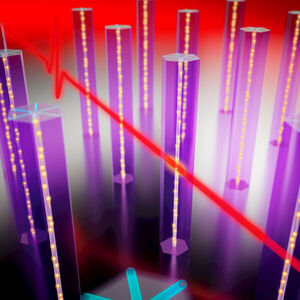
Speeding through nanowire
"Nanowires under tension create the basis for ultrafast transistors Smaller chips, faster computers, less energy consumption. Novel concepts based on semiconductor nanowires are expected to make transistors in microelectronic circuits better and more efficient. Electron mobility plays a key role in this: The faster electrons can accelerate in these tiny wires, the faster a transistor can switch and the less energy it requires. A team of researchers from the Helmholtz-Zentrum Dresden-Rossendorf (HZDR), the TU Dresden and NaMLab has now succeeded in experimentally demonstrating that electron mobility in nanowires is remarkably enhanced when the shell places the wire core under tensile strain. This phenomenon offers novel opportunities for the development of ultrafast transistors. Nanowires have a unique property: These ultra-thin wires can sustain very high elastic strains without damaging the crystal structure of the material." [...]

Study raises new possibilities for triggering room-temperature superconductivity with light
"Scientists discover that triggering superconductivity with a flash of light involves the same fundamental physics that are at work in the more stable states needed for devices, opening a new path toward producing room-temperature superconductivity. Much like people can learn more about themselves by stepping outside of their comfort zones, researchers can learn more about a system by giving it a jolt that makes it a little unstable – scientists call this “out of equilibrium” – and watching what happens as it settles back down into a more stable state. In the case of a superconducting material known as yttrium barium copper oxide, or YBCO, experiments have shown that under certain conditions, knocking it out of equilibrium with a laser pulse allows it to superconduct – conduct electrical current with no loss – at much closer to room temperature than researchers expected. This could be a big deal, given that scientists have been pursuing room-temperature superconductors for more than three decades. But do observations of this unstable state have any bearing on how high-temperature superconductors would work in the real world, where applications like power lines, maglev trains, particle accelerators and medical equipment require them to be stable? A study published in Science Advances today suggests that the answer is yes." [...]

Future gravitational wave detector in space could uncover secrets of the Universe
"New research has shown that future gravitational wave detections from space will be capable of finding new fundamental fields and potentially shed new light on unexplained aspects of the Universe. Professor Thomas Sotiriou from the University of Nottingham’s Centre of Gravity and Andrea Maselli, researcher at GSSI and INFN associate, together with researchers from SISSA, and La Sapienza of Rome, showed the unprecedented accuracy with which gravitational wave observations by the space interferometer LISA (Laser Interferometer Space Antenna), will be able to detect new fundamental fields. The research has been published in Nature Astronomy. In this new study researchers suggest that LISA, the space-based gravitational-wave (GW) detector which is expected to be launched by ESA in 2037 will open up new possibilities for the exploration of the Universe. Professor Thomas Sotiriou, Director of the Nottingham Centre of Gravity explains: “New fundamental fields, and in particular scalars, have been suggested in a variety of scenarios: as explanations for dark matter, as the cause for the accelerated expansion of the Universe, or as low-energy manifestations of a consistent and complete description of gravity and elementary particles. We have now shown that LISA will offer unprecedented capabilities in detecting scalar fields and this offers exciting opportunities for testing these scenarios.” Observations of astrophysical objects with weak gravitational fields and small spacetime curvature have provided no evidence of such fields so far." [...]

New soft robot morphs from a ground to air vehicle using liquid metal
"Imagine a small autonomous vehicle that could drive over land, stop, and flatten itself into a quadcopter. The rotors start spinning, and the vehicle flies away. Looking at it more closely, what do you think you would see? What mechanisms have caused it to morph from a land vehicle into a flying quadcopter? You might imagine gears and belts, perhaps a series of tiny servo motors that pulled all its pieces into place. If this mechanism was designed by a team at Virginia Tech led by Michael Bartlett, assistant professor in mechanical engineering, you would see a new approach for shape changing at the material level." [...]
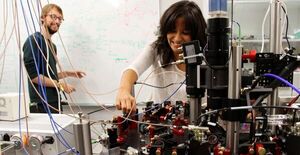
Using the universe’s coldest material to measure the world’s tiniest magnetic fields
"Using atoms only a few billionths of a degree above absolute zero, a team of researchers from ICFO and Aalto University have detected magnetic signals undetectable by any other existing sensor technology. Magnetometers measure the direction, strength or relative changes of magnetic fields, at a specific point in space and time. Employed in many research areas, magnetometers can help doctors to see the brain through medical imaging, or archaeologists to reveal underground treasures without excavating the ground. Some magnetic fields of great interest, for example those produced by the brain, are extraordinarily weak, a billion times weaker than the field of the Earth, and therefore, extremely sensitive magnetometers are required to detect these weak fields. Many exotic technologies have been invented for this purpose, including superconducting devices and laser-probed atomic vapors. Even the impurities that give some diamonds their color have been used as magnetic sensors." [...]

Fusion energy record demonstrates powerplant future
"Record results announced today are the clearest demonstration worldwide of the potential for fusion energy to deliver safe and sustainable low-carbon energy. Researchers from the EUROfusion consortium – 4,800 experts, students and staff from across Europe, co-funded by the European Commission – more than doubled previous records achieved in 1997 at the UK Atomic Energy Authority (UKAEA) site in Oxford using the same fuel mixture to be used by commercial fusion energy powerplants. 59 megajoules of sustained fusion energy was demonstrated by scientists and engineers working on the Joint European Torus (JET), the largest and most powerful operational tokamak machine in the world. The record and scientific data from these crucial experiments are a major boost for ITER, the larger and more advanced version of JET. ITER is a fusion research mega-project supported by seven members – China, the European Union, India, Japan, South Korea, Russia and the USA – based in the south of France, to further demonstrate the scientific and technological feasibility of fusion energy. As pressures mount to address the effects of climate change through decarbonising energy production, this success is a major step forward on fusion’s roadmap as a safe, efficient, low carbon means of tackling the global energy crisis." [...]

Creating a better plastic
"Carolina chemists may have a solution to the country's plastic problem by "upcycling" plastic trash to tougher, stronger material. The United States generates more plastic trash than any other country — about 46.3 million tons of it — or 287 pounds per person a year, according to a 2020 study. The country’s 9% rate of recycling will never keep up. Why so low? The chemistry of today’s plastics makes most difficult to recycle. Even thermoplastics that can be melted down weaken with each re-use." [...]
Projetos Maker
Diversos Projetos interessantes.

Raspberry Pi 4 - Multiple SPIs
"In this post I want to talk about the new Raspberry Pi 4 (RPI4) and one of its new features: Multiple (up to 6) accessible SPIs! While the older RPIs all had SPI0, SPI1 and SPI2, only SPI0 and SPI1 where accessible through the pin headers. Now there are SPI3 through SPI6 in addition to that! I'll assume you know your way around the command line and that you know what SPI is. For an explanation of what I'm doing here, what a device tree and an overlay is, read the article about the Device Tree. SPI Overlays To use any interface on the hardware pins, the desired interface has to be enabled first." [...]
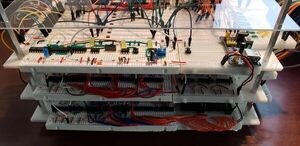
Stacks - A16-Bit Breadboard Processor
"Project to simulate, design, and build a 16-bit breadboard computer. The breadboards are installed in a 3-layer plastic enclosure for circuit stabilization and protection. I designed my own hardware architecture and instruction set architecture (ISA) loosely based on RISC-V. The design includes an Arduino NANO interface to download compiled assembler code to breadboard program RAM (goal). This project is a follow-on to an 8-bit breadboard ala Ben Eater (eater.net) or similar. " [...]

The Ping Clock
"Are you ever in a video call, when the other party suddenly freezes mid-sentence, leaving you wondering after a few seconds of silence: is it my connection that's having issues, or theirs? In such situations, one glance at the ping clock dial provides an immediate overview of your internet connection status and health, measured in terms of ping time. Ping time is the time it takes for a network packet to reach a certain destination host and come back again. Lower is better; for video calls, anything below a few tenths of a second is typically fine. The host can be chosen as a public server with high reliability (for example, google.com or 80.80.80.80), or as something with a special significance (like the hostname of your cloud instance). If your video call freezes, but the ping clock continues to indicate low ping, there is no need to reset your router; just wait for the other side to come back." [...]
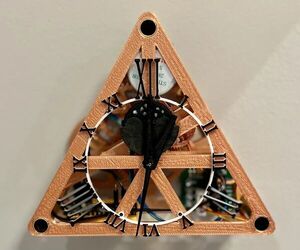
Triangulum - 3D Printed 3-Hand Clock
"Hey! So this is a project I started April 8 2021, and since then, it has changed quite a bit. The basic idea was to make a clock shaped like a triangle. This morphed into a 3-hand clock with a moon phase tracker. The name Triangulum fits well because it is a triangular constellation, much like the shape of the clock. This clock uses the same code as the Holo Clock with some minor improvements." [...]

Make Esp8266 Mood Light
"In this project, I’ll show you how you can build your own mood light. You’ll use an ESP8266 to remotely control the color of your light Hey friends welcome back today in this tutorial I will show you how to Make Esp8266 Mood Light control with smartphone. In this project, I’ll show you how you can build your own mood light. You’ll use an ESP8266 to remotely control the color of your light using your smartphone. This project is called $7 DIY WiFi RGB LED Mood Light. Before going to the details let me explain the basic features of my Mood Light." [...]

MicroMaster Mini
"The MicroMaster Mini is the next generation of hardware hacking tool. Not Another Bus Pirate... - The MicroMaster Mini, like the Bus-Pirate, Shikra, and Hydrabus before it, is a small circuit board that communicates to a computer via a Virtual COM port. - The purpose of the MicroMaster Mini is to allow the user to test commands that may be sent from a master to a slave device using a variety of protocols such as UART, CAN, I2C, SMBUS, SPI, 1-Wire, WS2812 (neopixel) and PWM. The MicroMaster Mini also allows the user to "sniff" CAN, SMBUS, UART, and I2C transactions. - Unlike the Bus-Pirate and Bus-Pirate derived devices, the MicroMaster Mini employs a highly sophisticated serial interface that has a system of pages similar to a web browser that can be navigated and manipulated with an ASCII keyboard. - Allows users to monitor the registers of I2C devices and SPI devices in real time." [...]

HID-compliant Auxiliary LCD Display for PC
"This project allows an Arduino board with USB capabilities and connected LCD screen to act as a HID-compliant Auxiliary Display for your PC This project allows to connect a small text LCD display to the host PC using the standard HID-compliant protocol over the USB, and print a processed output of any shell command, that can be executed on the host PC. The text on the LCD screen you see on the photo has been combined from the output of 2 shell commands (I'm using Linux host): date "+%d%m%y %T" and sensors -u | grep --no-messages -A 3 coretemp-isa | grep temp1_input | awk '{print $2}' | awk '{printf("%d\n",$1 + 0.5);}' The commands are configurable so the output can be anything, including but not limited to CPU temp, GPU temp, available RAM, CPU load, FAN speed, current date/time etc. There is no limitation on which commands can be used - basically anything that you can type in the terminal and get some output, can be displayed on the LCD. Let me share some background why I started this project. My initial need was to add a small LCD monitor to my home theater PC, which is also used as a gaming rig and an AI training device since it has 2 powerful GPU on board. Sometimes CPU and GPU were getting pretty hot so I wanted to have a small display on the box itself showing its temperature and other parameters continuously." [...]
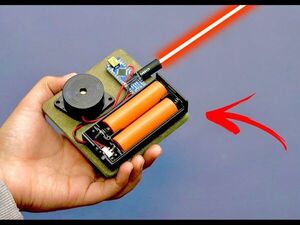
Make Tripwire Security Alarm Using Arduino
"Hey friends welcome back today in this articlei will show you how to Make Tripwire security Alarm using Arduino. in this tutorial You will learn how to use a photo resistor. A tripwire is a device triggered by physical movements, you can use it to detect people, animals, cars or etc when they pass through an laser area. Supplies: - Arduino Nano - Buzzer - Battery Holder - Laser - LDR Sensor - wire" [...]

PLOTTYBOT
"This is PlottyBot, a pen plotter you can build. It’s based on a Raspberry Pi Zero W which means it’s loaded with software to make it easy to use. It also comes with novel features. " [...]

An Arduino-based USB interface to the Psion Organiser II
"I built a hacky USB interface to the Psion Organiser II that lets you send messages to it over USB serial via an Arduino Nano. It involves the organiser executing machine code stored in a string in its BASIC-like language, and it totally abuses the CPU's bus design. But it's simple and it works. The motivation is that Martin wanted to use the Psion to display notifications, but couldn't find anywhere to buy the "CommsLink" module that connects it to a PC. I thought it sounded like a fun Arduino project, so I did it. " [...]
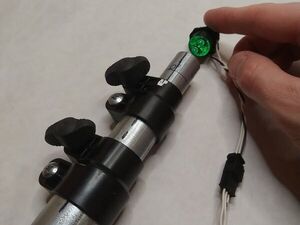
Telescoping Pole Extension Sensing Methods - Photoresistor
"I outline seven different techniques to measure the length of a telescoping EMT conduit pole, and demonstrate a photoresistor-based method. This article is part of a series discussing methods for adding sensing capabilities to a DIY telescoping pole project made from EMT conduit. This article presents: Seven different methods for sensing the extension length of a telescoping pole made from EMT conduit! An in-depth look at the photoresistor-based technique among that list of methods. While the extended length of a telescoping pole can be simply measured using a tape measure, a system for continuously taking such measurements is useful for many different telescoping pole applications and projects: - Know if the pole has slipped - Set a repeatable length (e.g. deployable fruit picker) - Flagpole height measurement, at full mast, half mast, or anywhere in-between - Set the height of an archery or hunting target - Use the telescoping pole itself as a measuring stick - And more!" [...]
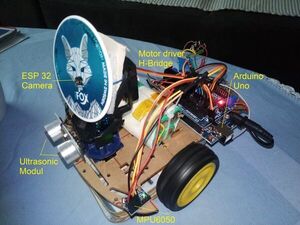
Making a 2WD Arduino Vehicle Drive Straight
"One of the challenges is to get the robot to go in a straight line. With this information, we can instruct our robot to go straight. For this project, we will only need a two (or four-wheeled) robot with appropriate motor drivers, an Arduino Uno board, and an Accelerometer and Gyroscope MPU6050. By using a ready chassis it is possible quickly build a working model. If you buy "Robot Smart Car Kit" that includes a chassis, wheels, motors and other mechanical components, to build the robot, we will need only few additional electronics to control the motors and sensors to detect position. The whole electronic design was made based on the Arduino Uno." [...]

Loopie - DIY RGB LAMP
"A minimalistic RGB LED Lamp Meet Loopie, a minimalistic, enticing RGB LED lamp that can easily fit everywhere in your living space. The unique mystic shape of this lamp will make you lose all sense of time. In this video, we will be guiding you through the steps explaining how to build it on your own. It's very cheap and easy to replicate. Are you interested in doing it yourself? Let's get building." [...]
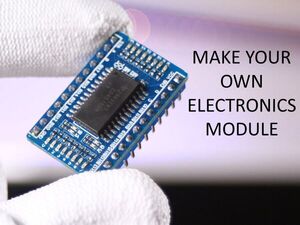
Make Your Own Circuit Module (CD4515 Decoder)
"If you are willing to learn how to produce your own circuit, then maybe this post could give you some tips! I have detailed the making steps of an Electronics Breakout board for CD4515 Decoder (you can follow the same steps for whatever other Integrated Circuit). The main purpose from this breakout board is keeping an arranged looking of my breadboard while prototyping bigger circuits. " [...]
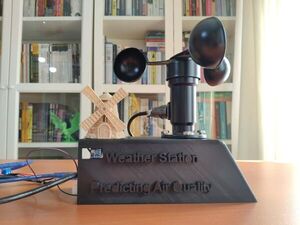
O3-enabled BLE Weather Station Predicting Air Quality w/ TF
"Via Nano 33 BLE, collate local weather data, build and train a TensorFlow neural network model, and run the model to predict air quality. Since the risk of breathing polluted air with poor quality has been increased precipitously in recent decades, measuring air quality to take precautions so as to keep our respiratory system healthy is crucial, especially for sensitive groups, which include people with lung disease such as asthma, older adults, children, teenagers, and people who are active outdoors[1]. Even though there are international efforts to reduce air pollution and deplete air pollutants, tracking air quality locally to get prescient warnings regarding pulmonary risk factors is yet a pressing issue. Although many factors can lead to poor air quality, the two most common are related to elevated concentrations of ground-level ozone and particulate matter. Ground-level ozone forms when nitrogen oxides (NOx) from sources like vehicle exhaust and industrial emissions react with organic compounds in the presence of heat and sunlight. In other words, ozone forms when two types of pollutants (VOCs and NOx) react in sunlight." [...]
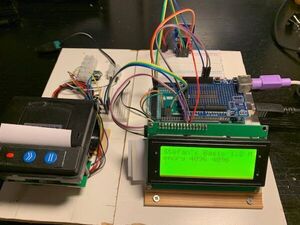
AIM65 lookalike computer from scratch
"AIM65 is a legendary single board computer from the 70s. I build on from scratch using Arduino standard components. The idea The Rockwell AIM 65 was one of the early 6502 based computers of the 70s. It had a 20 character display, a little thermo printer and a fairly big keyboard. Standard memory was 1k or 4k. More details can be found on the "old computers" page." [...]
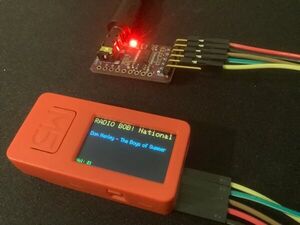
ESP32 internet radio with I²S DAC
"WiFi internet radio built using an M5StickC plus (ESP32 Pico), external I²S DAC (PCM5102A), and stereo amplifier (Onkyo TX SV 434). After discovering that my 25 years old Onkyo stereo amplifier is still working, I wanted to give it a second life. An M5StickC Plus (ESP32 pico) which I had obtained some time ago should serve as internet radio player. It provides built-in WiFi, an LCD, some buttons, and I²S output for digital audio. To achieve a sufficiently high audio quality, I decided to use an external digital-to-analog audio converter, the PCM5102A, with a line-out port. Luckily, some similar projects exist already, and there is a great library - the ESP32-audioI2S - which does most of the work." [...]
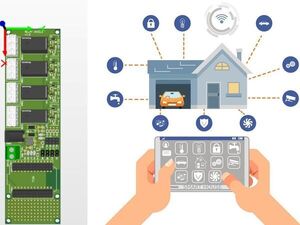
Relay Shield PCB Design Useful for IoT Applications
"Relay Shield can be used to be control devices wirelessly with your smartphone from anywhere. Every household has electronic devices which are a major part of our everyday life like dishwashers, washing machines, boilers (water heaters), kettles. All of the previous devices are a combination of mechanical – electronic – power sets. The main part of devices operation is electrical power. It’s well known that AC electrical power is dangerous for humans and that’s exactly the type of power for devices operation. For example, if you leave your kids at home alone, they could turn on, by accident, an electrical stove which can produce fire in your house." [...]
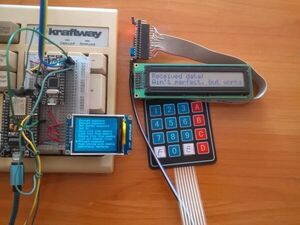
Password Vault V3.0
"Let me begin this tutorial by reminding you that storing your passwords in an unencrypted form is the same as keeping the key from your house under the mat. Your house might have the best lock in the world, but what's the point in it if you keep the key from it in an easily accessible place? That's the problem I'm trying to solve by making this device. I'm trying to give you the ability to securely store your passwords, keys, and other important stuff. This version of the password vault is a device that has the capability to encrypt your passwords, store the encrypted passwords in its built-in memory, hash passwords, and securely send passwords to another device. In addition to that, you can also set the master password and the initialization vector (increment the key) to prevent an attacker from decrypting your passwords by simply obtaining physical access to your vault." [...]
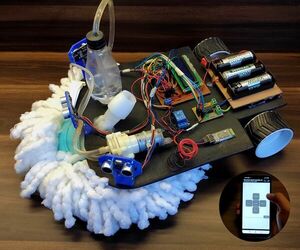
The Ultimate Floor Cleaning Robot (v2.0)
"Around 5 years back I made a Floor Cleaning Robot (CleanSweep) from scratch, which was a hit and a lot of people followed the guide and tried making their own robot. But that design actually had some flaws. So last year I had to make my Engineering Mini Project and I decided to work on the same idea but with some improvements. However, it is quite ironical that even after 3 years of university I worked on the same project that I built when I was in school (lol). In this instructable, I will present you Version 2.0 of the Floor Cleaning Robot, with some improvements over the previous version. This one is also controlled from a phone app via bluetooth but here I have also added autonomous control (which a lot of people requested)." [...]
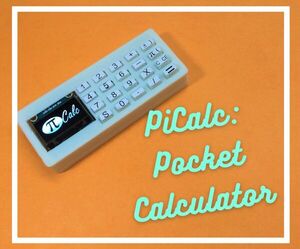
PiCalc: Raspberry Pi Pico Based Pocket Calculator
"It's quite rare these days to find someone carrying a pocket calculator but school students who are don't allowed to carry phones may use it, or why don't they create their own pocket calculator. In this Instructable, I will show you how I made a pocket calculator using raspberry pi pico and that's where it gets its name PiCalc. Supplies: - Raspberry Pi Pico - SSD1306 OLED display module 128^64 - 20 X SMD Momentary Switches (6x3.5mm) for Keypad - Slide Switch for Power On/Off - Lipo Battery smaller than 30mmx30mmx4mm - TP4056 Lipo Charge/Protection Circuit - Some 3D Printed Parts - Copper Clad + Glossy Paper + Ferric Chloride if you are going to make PCB by yourself" [...]
Secção Videos
Videos interessantes.
That's all Folks!



